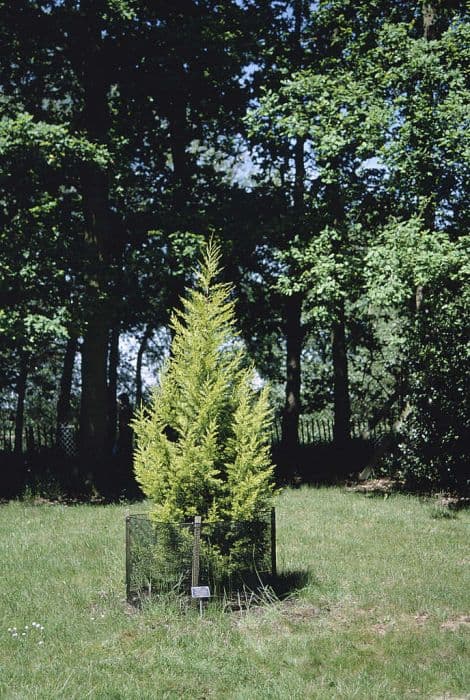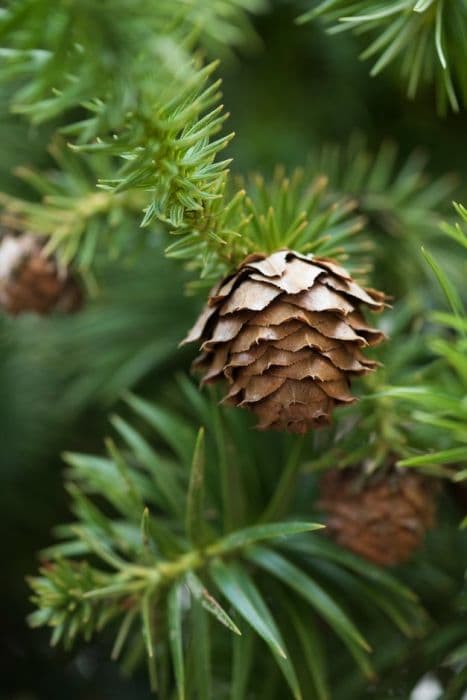Port Orford Cedar Chamaecyparis lawsoniana 'Gimbornii'











ABOUT
The Chamaecyparis lawsoniana 'Gimbornii', commonly known as the Lawson cypress 'Gimbornii', has a distinctive and decorative appearance that makes it stand out in any landscape. This evergreen conifer features dense, soft, and fine-textured foliage. The leaves are arranged in flattened sprays that cling closely to the branches, giving the plant a somewhat feathery look. The color of the foliage is a rich green, which can vary in tone from deep hues to a slightly blue-green shade in some specimens. The Lawson cypress 'Gimbornii' is characterized by its symmetrical and conical shape, creating an elegant silhouette. The branches extend from the central trunk in a somewhat horizontal manner, though they appear to be layered due to the close-set foliage. This dense branch structure contributes to the overall compact appearance of the plant. During different seasons, the Lawson cypress 'Gimbornii' may display subtle changes in color, making it a visually appealing addition throughout the year. The cones of this plant are small and inconspicuous, generally blending in with the foliage rather than standing out. The bark, when visible, is often a reddish-brown color that becomes more textured and furrowed with age. Overall, the Lawson cypress 'Gimbornii' presents an attractive profile with its lush, evergreen foliage, and tidy, pyramidal form.
About this plant
 Names
NamesFamily
Cupressaceae.
Synonyms
Gimborn Lawson Cypress, Dwarf Lawson Cypress, Miniature Lawson False Cypress.
Common names
Chamaecyparis lawsoniana 'Gimbornii'.
 Characteristics
CharacteristicsLife cycle
Perennials
Foliage type
Evergreen
Color of leaves
Blue-green
Height
3-4 feet [0.91-1.22 meters]
Spread
2-3 feet [0.61-0.91 meters]
Plant type
Tree
Hardiness zones
5
Native area
North America
Benefits
 General Benefits
General Benefits- Erosion Control: Chamaecyparis lawsoniana 'Gimbornii', commonly known as Lawson's Cypress, has a root system that can help stabilize soil and prevent erosion.
- Wildlife Habitat: Lawson's Cypress provides shelter and nesting sites for various species of birds and small mammals.
- Ornamental Value: With its compact growth and attractive foliage, this plant is often used in ornamental gardens for visual appeal.
- Privacy Screen: Its dense growth habit makes it an excellent choice for creating privacy screens or hedges in landscaping.
- Windbreak: The thick foliage can act as a windbreak, offering protection for gardens and structures from strong winds.
- Sound Barrier: Lawson's Cypress can help reduce noise pollution by absorbing and blocking sound with its branches and leaves.
- Climate Tolerance: It is known for having good resistance to various climatic conditions, making it suitable for a range of environments.
- Low Maintenance: This plant typically requires minimal pruning and care, making it a convenient option for gardeners of all levels of experience.
 Medical Properties
Medical PropertiesThis plant is not used for medical purposes.
 Air-purifying Qualities
Air-purifying QualitiesThis plant is not specifically known for air purifying qualities.
 Other Uses
Other Uses- Miniature Bonsai: Chamaecyparis lawsoniana 'Gimbornii' can be trained as a miniature bonsai, perfect for enthusiasts who enjoy crafting small-scale, intricate landscapes.
- Woodworking Projects: The wood of this plant, commonly known as Lawson's Cypress, can be used for small woodworking projects like crafting jewelry boxes, due to its fine grain and workability.
- Model Making: Its fine foliage and small scale make Lawson's Cypress ideal for creating realistic trees and landscapes in model train sets or architectural models.
- Essential Oils: While avoiding medical uses, the foliage can be steam-distilled to produce essential oils that are used in aromatherapy for their woodsy scent.
- Scented Sachets: Dried foliage can be placed into sachets to provide a natural, fresh aroma in drawers and closets.
- Christmas Decor: Lawson's Cypress, being evergreen and compact, can be decorated and used as a living Christmas ornament or tabletop tree during the holiday season.
- Ornamental Topiary: This plant is well-suited for topiary, where it can be trimmed into decorative shapes and forms for garden art.
- Educational Tool: Schools and educational programs can use Lawson's Cypress to teach students about plant growth, conifer lifecycle, and horticultural practices.
- Habitat for Wildlife: When planted outdoors, Lawson's Cypress provides shelter and nesting sites for birds and beneficial insects within its dense foliage.
- Photography Projects: The unique appearance of Lawson's Cypress makes it a great subject for botanical photography and helps in creating awareness about plant diversity.
Interesting Facts
 Feng Shui
Feng ShuiThe Port Orford cedar is not used in Feng Shui practice.
 Zodiac Sign Compitability
Zodiac Sign CompitabilityThe Port Orford cedar is not used in astrology practice.
 Plant Symbolism
Plant Symbolism- Endurance: As an evergreen plant, Lawson's Cypress 'Gimbornii' symbolizes strength and the ability to endure hardships, as it remains green and vibrant throughout the seasons.
- Longevity: This plant can live for many years, often symbolizing long life and immortality.
- Protection: Lawson's Cypress 'Gimbornii' is commonly used in horticulture as a windbreak, thus it's also seen as a symbol of protection and shelter.
- Purity: With its dense foliage and clean, fresh scent, this plant is frequently associated with purity and cleanliness.
 Water
WaterThe Port Orford cedar, being a conifer, likes consistent moisture but does not tolerate soggy conditions, so it is important to allow the soil to dry slightly between waterings. Generally, it should be watered once a week, using about 1.5 to 2 gallons for an established tree, depending on the climate and soil drainage. During hotter seasons or in dry climates, you may need to water twice a week, ensuring that the water penetrates deeply into the soil to encourage deep root growth. In cooler or wetter weather, reduce watering frequency to prevent root rot. Overwatering can be as harmful as underwatering, so monitor the soil moisture regularly.
 Light
LightThe Port Orford cedar thrives in full sun to partial shade, making it versatile for various garden locations. It performs best in a spot that receives at least six hours of direct sunlight each day, but it can also tolerate some light afternoon shade, especially in hotter regions. Avoid deep shade as this can lead to sparse foliage and poor growth.
 Temperature
TemperatureThe Port Orford cedar can tolerate a wide range of temperatures, from as low as 20 degrees Fahrenheit in the winter to over 90 degrees Fahrenheit in the summer. It prefers a cooler climate, optimally growing in areas where the average temperature is between 60 and 75 degrees Fahrenheit. It's important to protect the tree from harsh winter winds and extreme heat when possible.
 Pruning
PruningPrune the Port Orford cedar to maintain its shape and health, removing any dead, damaged or diseased branches. Light pruning can be done at any time of year, but major pruning should be done in the late winter or early spring before new growth starts. Avoid heavy pruning; instead, focus on thinning out the branches to allow light and air to penetrate the canopy, which helps prevent disease.
 Cleaning
CleaningAs needed
 Soil
SoilThe best soil mix for Lawson's Cypress 'Gimbornii' should be well-draining with a mixture of peat, coarse sand, and perlite or pine bark. Maintain soil pH between 5.0 to 7.0 for optimal growth.
 Repotting
RepottingLawson's Cypress 'Gimbornii' typically requires repotting every 2 to 3 years to prevent root-bound conditions and to refresh the soil medium.
 Humidity & Misting
Humidity & MistingLawson's Cypress 'Gimbornii' prefers moderate to high humidity levels, ideally between 40% to 70%, to thrive indoors or in a nursery environment.
 Suitable locations
Suitable locationsIndoor
Grow Lawson's Cypress 'Gimbornii' indoors in a bright, cool spot with high humidity.
Outdoor
Plant Lawson's Cypress 'Gimbornii' in partial shade, well-draining soil, and shelter from strong winds.
Hardiness zone
5-8 USDA
 Life cycle
Life cycleChamaecyparis lawsoniana 'Gimbornii', commonly known as Lawson's Cypress, begins its life cycle as a seed, which after stratification, germinates when exposed to suitable temperatures and moisture levels. The seedling stage follows, characterized by the development of a primary root and shoot, which will further grow into a juvenile plant with a recognizable coniferous structure. As it enters the vegetative stage, Lawson's Cypress undergoes significant height and girth increase, producing scale-like leaves and establishing a strong root system. During the reproductive stage, the mature plant develops cones—male ones release pollen while female ones receive it during the pollination period, leading to fertilization and seed development. After seed dispersal, the cycle can begin again, while the parent tree continues to grow and may live for several hundred years if environmental conditions are favorable. The final stage in the plant’s life cycle is senescence, during which growth slows, and the tree eventually dies, possibly succumbing to environmental stresses, disease, or old age.
 Propogation
PropogationPropogation time
Early spring
The most popular method of propagation for the Port Orford cedar, also known by its botanical name Chamaecyparis lawsoniana 'Gimbornii', is through semi-hardwood cuttings. This process typically takes place in late summer to early autumn. Cuttings about 4 to 6 inches (10 to 15 cm) long are taken from the current year's growth, ensuring each cutting has several nodes. The lower needles are stripped off, and the cut end is dipped in a rooting hormone to encourage root development. The cuttings are then inserted into a soil mix that is well-draining, often a combination of peat and perlite, ensuring that at least one node is below the soil surface. The soil is kept moist but not wet, and the cuttings are placed in a well-lit area, out of direct sunlight, and ideally under a mist system or with high humidity to prevent desiccation. With proper care, roots typically develop within a few months, after which the new plants can be transferred to individual pots and grown on before planting out.









